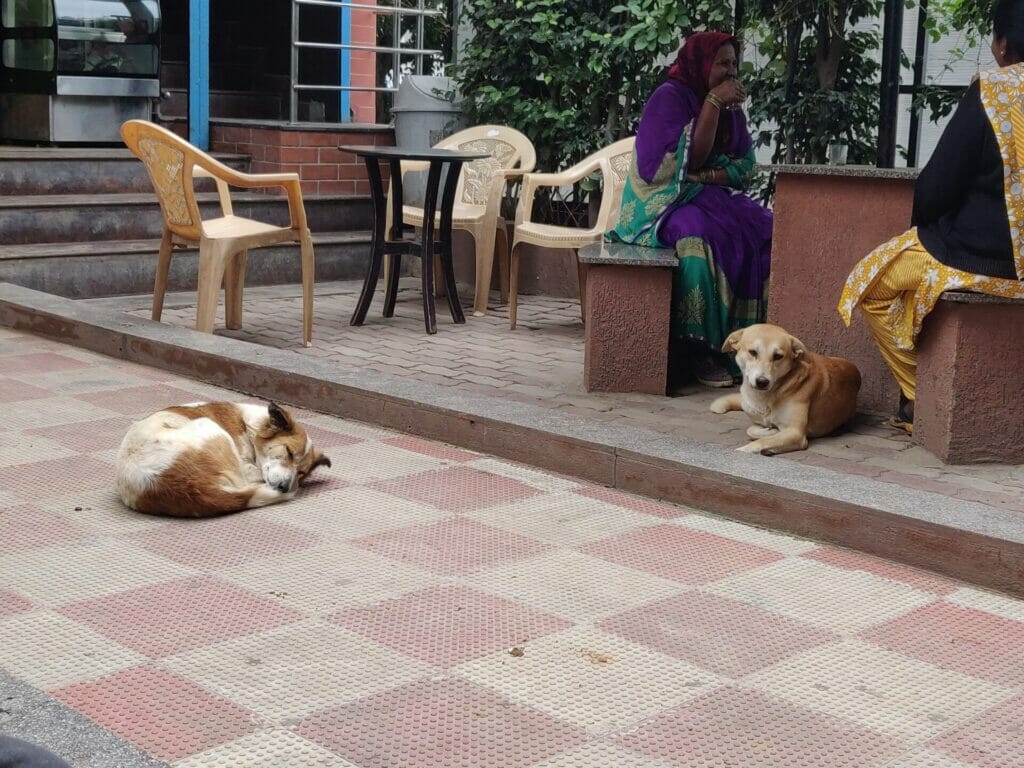Streeties or free-living dogs (FLDs) are frequently at the centre of much controversy regarding human-animal conflict and zoonotic diseases like rabies. These issues can cause trauma and claim lives. It is, hence, our collective responsibility to address it.
Some experts are of the opinion that the only viable approach is the complete eradication of these dogs. But is this approach workable in India? Should other approaches also be considered? Are there certain beliefs that make some people insist on one approach over the other? What should our considerations be when we discuss what is the right approach for India?
There are questions like these, and many more, that need to be addressed. This is a complex topic, but the conversation needs to start somewhere.
Can street dogs be removed en masse?
Let us start by asking if it is viable to just eradicate streeties. It was revealed as far back as 1964, by Blue Cross India that the catch-and-kill programme that was run by the Madras Corporation for over a hundred years had in fact been unsuccessful (Krishna, 2009). Since then, there have been several studies that have shown that removing dogs en masse does not have a desirable effect on rabies eradication (Smith et.al. 2019, Taylor et.al. 2017, Wandeler 1993, Kumarapeli, Awerbuch-Friedlander, 2009).
More recently, the conversation is moving away from killing as a way to eradicate streeties. Instead, there is a call for getting all of them adopted or moving them into shelters. These are considered more humane alternatives to the mass killing of streeties.
A quick check-in with people who facilitate the adoption of such dogs will reveal a cultural resistance to adoptions of “Indies”. So, one can only imagine the infeasibility of getting approximately a million such dogs adopted.
But, what if there were shelters to house these dogs temporarily, while simultaneously a gradual cultural change is made, to get the dogs adopted from shelters, the way it seems to be done in the US and parts of Europe. This definitely sounds like a nice, humane solution.

Read more: Interview: “Feeding of any animal, including stray dogs, in public places should be stopped”
Can we house street dogs in shelters?
But, what about the cost and logistics of building sufficient facilities and skills to house, feed, and care for a million animals?
A few years ago, I met a veterinary nurse who worked in a shelter in another Asian country that has street dogs and also has government-run facilities. She spoke to me of an instance where one of the government facilities came under such neglect that several dogs were left to starve and kill each other. Is it really humane if the horrors of “eradication” happen out of our sight?
While government neglect of massive facilities housing unaccounted-for animals is not improbable, let us set aside the image of dogs eating dogs and assume that somehow we are able to get all the dogs adopted. We are faced with an additional challenge that is, in fact, identified by some of the very experts who advocate this approach.
A study by Radhakrishna, Vanak and colleagues (2020) found “there is little emphasis on promoting responsible dog ownership practices”, highlighting what they may be suggesting are “poor standards of ownership”.
Furthermore, a paper by Taylor and colleagues says, “The Humane Society of the US estimates that each year $2.5 billion is spent by humane organizations and $800 million to $1 billion is spent by animal control organizations on managing the pet overpopulation problem” and goes on to conclude “for practical, economic, and welfare reasons, in most rabies-endemic settings alternatives to shelters, must be explored fully prior to any commitment to build one”.

Does moving dogs to shelters mean no conflict and no rabies?
Let us assume that we manage the Herculean task of setting up shelters for a million or so dogs, that we catch and move all the dogs into the shelters, staff them well enough to keep the dogs alive, and run a massive campaign affecting the cultural shift to adopt and responsibly own dogs. Is this approach effective?
Would we rid ourselves of free-living dogs, conflict, and zoonotic diseases? Quite unlikely. All ecosystems, urban ecosystems included, have a holding capacity or the ability to support life. If we erase one form of life, another may take its place, which may bring its own problems. Dog populations may be replaced by rat populations, which can then pose some severe problems for humans.
Unlike dogs, rats cannot be caught and vaccinated, and unlike dogs, rats can find their way into our homes with the ability to contaminate our food and water. I live on a farm and out here, we have the additional challenge that if dog populations go down and rat populations go up, snakes increase too. While, personally, I find snakes rather fascinating, the point is not which animal we like or prefer. The point is that dogs are very much part of the interconnectedness of the living beings that occupy spaces that humans occupy. They have been part of this “ecological niche” for millennia and have a role to play.
Furthermore, massive kill or catch operations can shape the behaviour of entire populations. The dogs that get caught are usually more friendly and are the least wary of humans. The dogs that survive are likely to be more wary and fearful.
Epigenetics expression may also result in the transmission of fear across generations. Over the past few years, I have been exchanging notes with people from different parts of the world that have free-ranging dogs, and the pattern is evident: persecuted free-ranging dogs are wary of humans and more likely to get into conflict with them.
Read more: How to deal with street dogs in Bengaluru
Is feeding street dogs a problem?
There is one last challenge with attempts to eradicate free-living dogs in India. People who advocate for the eradication of streeties see the “caregiving tendencies” of Indians as problematic.
Taylor and colleagues (2017) say, “If free-roaming dogs are regularly fed by the community, changing attitudes and practices toward this activity may be extremely difficult”. In fact, Tiwari et. al. (2019a) report that almost 80% of the respondents in their study reluctantly admitted to feeding FLDs. Similar findings surface in several other papers (Tiwari et. al. 2019b, Saleem et. al. 2020, Srinivasan et. al. 2019, Gibson et. al. 2015).
Eradication of free-living dogs, either through killing or relocations, doesn’t seem viable in Indian conditions for various reasons. This approach is based on western models of cities and it has not been as effective in countries like India. In fact, free-living dogs are so prevalent that close to 70% of the dogs in the world are considered to be living free lives (Hughes 2013). Dande and Swart (2021) discuss the British legacy systems of dog management in Harare and highlight its limited “success”, if at all.
Read more: Bengaluru’s Canine Squads ensure well-being of street dogs and the local community
Are there feasible alternatives for the Indian context?
The question of the appropriateness of western solutions for India needs further examination and I will get back to it. But, right about now you are perhaps wondering if there are alternatives that are actually effective in India. We certainly have promising options.
There are documented case studies, from Chennai, Jaipur, Goa, Nilgiris etc., where a significant drop in rabies has been achieved through effective Animal Birth Control and Anti Rabies Vaccinations (ABC/ARV) programmes (Jackman and Rowen 2007, SAARC 2019).
There is sufficient evidence to suggest that vaccination and sterilisation hold great promise. But why has this not worked pan India? Why are success stories limited to small pockets?
Most reasons for this have nothing to do with the approach itself and have more to do with the funds available, and the rigour with which various governments implement the program. It takes funds to vaccinate, sterilise, capture, house, care for, relocate, and hygienically dispose of carcasses.
Regardless of what approach is pursued, the government will need to fund adequate multi-disciplinary research and country-wide implementation of these programs, along with adequate education.

Educating caregivers of street dogs
Any approach is going to need a massive nationwide effort. However, the ABC/ARV approach has unique allies that remain mostly ignored in conversations around free-living dog management. These are the people who are actually seen almost as “problematic” to efforts of street dog eradication. These are the people with “caregiving tendencies”! It seems like they need no incentive to provide care. Sadly, many of these people are routinely harassed, intimidated, and humiliated. However, if we were to encourage and educate them, their contribution to this effort may prove invaluable.
Fitzpatrick and colleagues (2016) show that the ABC/ARV costs can drop dramatically with help from such caregivers. Furthermore, the recently approved oral ARV reduces reliance on catchers and other veterinary staff, further dropping costs. It gets easier to decentralise the process, making it even more feasible (Gibson et.al. 2019, Yale et.al. 2022).
While “pet ownership” standards in India may be considered sub-par by some, there is no doubt that the “caregiving tendencies” towards streeties certainly surpass what western approaches account for. This needs to be factored in when we consider what is more appropriate for a country like India.
The problem with Western-modelled cities
The solutions of eradication advocated are modelled after western cities, which are devoid of most life forms. Western cities were built on an idea that separated nature from what they deemed “culture”. Culture was considered human’s ability to dominate nature. And cultures like ours, that see nature as something to preserve and revere, were considered “less evolved and savage”.
The colonial period gave rise to the idea of cities as sites of ultimate human domination. Everything, from insects to dogs, was more or less eradicated. Plants and animals that were allowed to survive in these spaces were just the ones that could be completely subjugated and controlled by humans. So, the outcome was manicured lawns, well-trimmed trees, and obedient animals.
The idea of free-living dogs was considered a direct affront to human domination. This was particularly annoying to the British Raj in India because the dogs of India posed a direct threat to the British dominion over all lives in the colonies.
Nadal says, “for a colonial power like Britain, this zoonosis was a constant reminder of one of its deepest fears…whatever deviated from the standards of orderliness, cleanliness, and discipline—culture’s tools in the mastery over the wildness of nature—was considered an anti-social force. ‘Stray or rabid dogs’ too, observes Kean, epitomised this threatening presence which cried out for regulation – or destruction.” (Nadal, 2019)
What works in the Indian context?
This brings us to the question of what is our idea of cities? Are they spaces devoid of all animal life that cannot be directly controlled by us? It also brings us to questions of what is effective in a country like India. What do we see as the government’s role here? Do we want governments to be managing a million sentient beings? Should we be putting effort into discouraging “caregiving” or are there ways to leverage it?
The good news is that there are people looking into these very topics. Srinivasan (2012, 2019) discusses the idea of cohabitation with dogs in urban spaces, while Narayanan (2017) discusses the same in the context of snakes. The University of Edinburgh is looking to understand the everyday knowledge of people dealing with street dogs from a one-health perspective.
Caregiving can be an asset for coexistence
As one can see, this is indeed a complex issue. There are several more aspects of this discussion that I have not addressed, like that of the welfare of the dogs in question or that of conflict with “feral-type” dogs that are very different from the FLDs we are used to in the cities. The topic needs nuanced multidisciplinary examinations.
My aim in this article is to only highlight that there are good reasons not to blindly consider western solutions as appropriate for India. But, instead, consider something that is in keeping with the reality of the country, its infrastructure and its people. “Caregiving”, while seen as a nuisance that gets in the way of establishing human domination, can be an asset if we aspire for coexistence.
Also read:
- Lessons from Charlie, the Indie dog that inspired a movie
- Is pet licensing the solution to illegal backyard breeding?
- A guide to travelling with pets on Indian Railways
- How to dispose of pet waste
- Pointers for those who want to help stray dogs and community animals in Chennai
- Surely Chennai, stray dogs at the Corporation pound deserve better than this!
Thanks for a very interesting and balanced article.
A few questions.
1. What about cats? Areas with lots of dogs tend to have almost no cats. I have seen my neighbourhood go from a cat-friendly place to almost having none. And dogs are one of the main culprits. The fewer cats there are, more the few that show up get set upon. Surely someone would want to talk about free-ranging cats and their welfare!
2. What about ethical feeding practices. A lot of ‘feeding’ is just cheap Glucose biscuits dumped in front of somebody else’s gate. There are AWBI guidelines about how and where to feed dogs. Few seem to follow them. Who is going to bell these feeders? And what about the food these dogs end up consuming here.
3. Garbage: Rats, dogs are all related to that one problem: garbage management. While the situation in some parts of Bangalore might be manageable, garbage in outskirts and rural areas is directly linked to the number of dogs.
4. Wildlife: Wildlife doesn’t mean just leopards, tigers and leopards. It can mean your local birds like lapwings that nest on the ground. Dogs are recorded to be predating on them. Squirrels and mongooses are also part of the city wildlife and their populations are affected by dogs.
5. Western cities are not devoid of wildlife: Coyotes, raccoons, foxes, bears in different parts of the world are all part of the urban ecosystem, just that they are not visible all the time.
Lastly, in Bangalore there seems to be little concerted effort on the ABC program. It waxes and wanes based on the interest of the BBMP. While we sit and argue about the number of dogs in the city and whether they are good or bad. Let us first demand a strong ABC program that has a plan and funding for the next decade. Any talk of feeding/shelters should go in parallel with that.
I love in suncity apartment and we have good number of cats and dogs around. Did not notice any population drop in cats. Also I have a open place near Bellandur lake which I call it a shelter for injured dogs. We have very balanced number of snakes, birds, reptiles. Dogs get enough food and freedom. They co exist with these creatures beautifully. They have some understandings between them. Kites and crows are always found around sleeping dogs. This place is very dense and bushy. I make sure no humans disturb or kill snakes here.
If the street dogs are not troubling the pedestrians and children, then they may be allowed to roam around in their areas. The municipal authorities can take action to vaccinate them for Rabies on an annual basis by tagging the dogs. Putting the dogs in canine shelters will not help. The dogs have to coexist with people. It is good to see many activists who are feeding these dogs.
How do the residents deal with issues when community dogs are taken care by dog lovers and people who don’t like dogs abuse each other verbally? This is in context when people live in apartments.